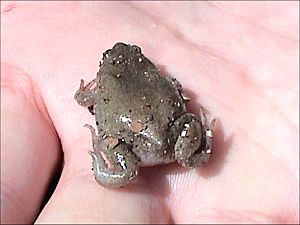List of amphibians of New Mexico facts for kids
New Mexico is a cool place with lots of different kinds of land, from tall mountains to dry deserts and grassy plains. Even though much of the state is dry, it's home to many amazing amphibians! Amphibians are creatures like frogs, toads, and salamanders. They are special because they can live both in water and on land.
Only one amphibian species in New Mexico is officially protected: the Chiricahua leopard frog (Rana chiricahuensis). This means it's a "threatened species," and efforts are being made to help it survive and thrive.
Toads: Bumpy-Skinned Hoppers
Toads are often confused with frogs, but they usually have drier, bumpier skin and shorter legs. They are excellent at living in drier places than many frogs.
True Toads: The Bufonidae Family
The Bufonidae family includes many of the toads you might recognize. These are often called "true toads."

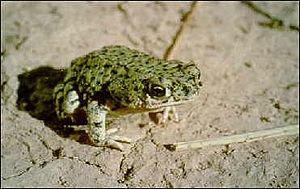
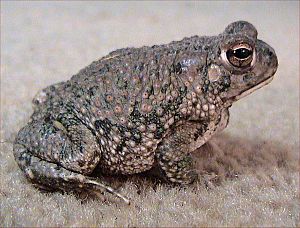
- Colorado River toad (Bufo alvarius): This is one of the largest toads in the area.
- Western toad (Bufo boreas): Found in western parts of North America.
- Great Plains toad (Bufo cognatus): Common in grasslands.
- Green toad (Bufo debilis): A smaller, often green-colored toad.
- Southwestern toad (Bufo microscaphus): Lives in the southwestern United States.
- Red-spotted toad (Bufo punctatus): Known for its reddish spots.
- Texas toad (Bufo speciosus): Found in Texas and nearby areas.
- Woodhouse's toad (Bufo woodhousii): A very common toad across many parts of the U.S.
Narrowmouth Toads: The Microhylidae Family
These toads have small, pointed heads and often burrow into the ground.
- Great Plains narrowmouth toad (Gastrophryne olivacea): This toad is small and often hides underground, coming out after rain.
Spadefoot Toads: The Scaphiopodidae Family
Spadefoot toads are special because they have a hard, spade-like bump on their back feet. They use this "spade" to dig backwards into the soil very quickly, especially when it's dry. They can stay buried for a long time, waiting for rain.
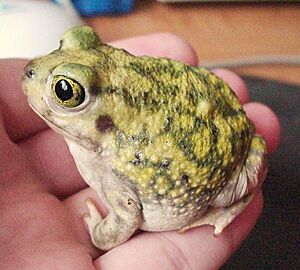
- Couch's spadefoot toad (Scaphiopus couchii): Known for its loud, bleating call.
- Plains spadefoot toad (Spea bombifrons): Another burrowing toad of the plains.
- New Mexico spadefoot toad (Spea multiplicata): A spadefoot toad found in New Mexico.
Frogs: Leaping Amphibians
Frogs typically have smooth, moist skin and long legs, perfect for jumping. They often live closer to water than toads.
Tree Frogs: The Hylidae Family
Tree frogs are known for their amazing climbing skills. They have special sticky pads on their toes that help them grip surfaces like leaves and branches.
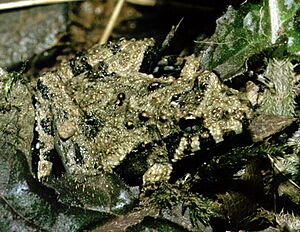
- Northern cricket frog (Acris crepitans): A very small frog with a call that sounds like crickets.
- Canyon tree frog (Hyla arenicolor): Often found in rocky canyons.
- Mountain tree frog (Hyla eximia): Lives in mountain areas.
- Western chorus frog (Pseudacris triseriata): Makes a "creaking" sound like a comb being run over.
Barking Frogs: The Leptodactylidae Family
These frogs are sometimes called "tropical frogs" and can make interesting sounds.
- Eastern barking frog (Eleutherodactylus augusti): Known for its bark-like call.
True Frogs: The Ranidae Family
The Ranidae family includes many of the common frogs you might see, often called "true frogs."

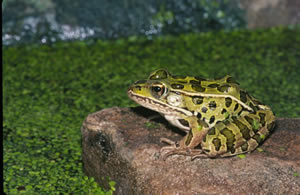
- Bullfrog (Rana catesbeiana): The largest frog in North America, known for its deep "jug-o-rum" call.
- Rio Grande leopard frog (Rana berlandieri): Found near the Rio Grande.
- Plains leopard frog (Rana blairi): Another spotted frog of the plains.
- Chiricahua leopard frog (Rana chiricahuensis): This is the threatened species we talked about earlier, very important to protect!
- Northern leopard frog (Rana pipiens): A common frog with distinct spots.
Salamanders: Lizard-like Amphibians
Salamanders look a bit like lizards, but they have moist skin and no scales. They need to stay damp to survive.
Mole Salamanders: The Ambystomatidae Family
These salamanders often live underground in burrows, like moles.
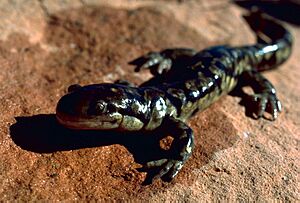
- Tiger salamander (Ambystoma tigrinum): This is the largest land salamander in North America, known for its bright yellow or orange spots.
Lungless Salamanders: The Plethodontidae Family
These amazing salamanders don't have lungs! They breathe through their skin and the lining of their mouths.
- Sacramento Mountain salamander (Aneides hardii): Found in the Sacramento Mountains.
- Jemez Mountains salamander (Plethodon neomexicanus): Lives in the Jemez Mountains.


